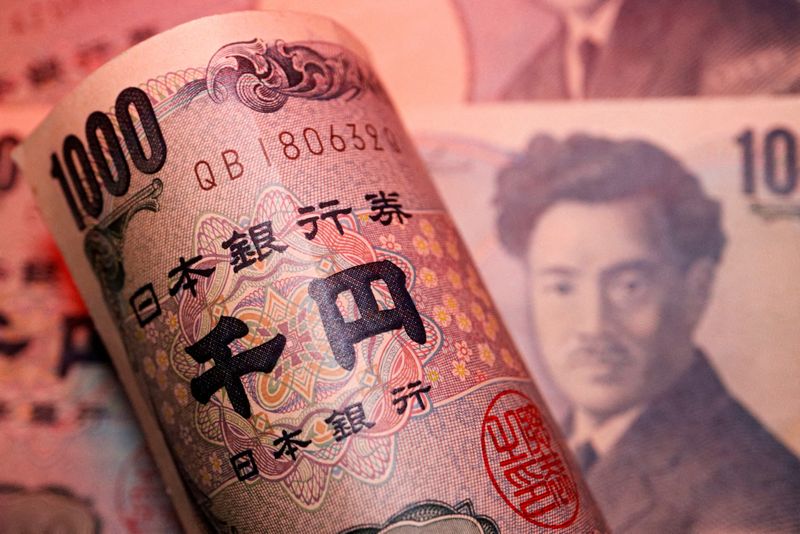By Kevin Buckland and Sruthi Shankar
TOKYO (Reuters) -The dollar slipped on Friday as investors fretted U.S. payrolls data could be weak after an unexpected slump in U.S. manufacturing raised concerns about a slowdown in the world's largest economy and lifted traditional safe-haven currencies.
The yen firmed, pushing the dollar down 0.3% to 148.90, building on gains in the wake of a Bank of Japan decision to raise rates and strengthening as far as 148.51 overnight for the first time since mid-March. The Swiss franc gained about 0.1% to 0.8718 per dollar, and earlier reached its highest since early February at 0.8707.
They were among the top performing currencies this week in the developed world, with gains of nearly 3% and 1.1%, respectively.
"What we're seeing this morning is a continuation of what we saw yesterday, which is markets striking a very risk-averse tone since the ISM manufacturing data," said Michael Brown, market strategist at Pepperstone in London.
"In the case of the yen, obviously you've got the continued carry unwind and safe-haven demand is in place as well."
The dollar slipped 0.15% against major currencies to trade at 104.21.
A measure of U.S. manufacturing activity fell to an eight-month low in July as new orders dropped, the Institute for Supply Management (ISM) said on Thursday, driving stocks on Wall Street sharply lower and bond prices higher.
U.S. 10-year Treasury yields plunged as much as 14 basis points to 3.965% overnight, breaching the psychological 4% barrier for the first time in six months, and extended those declines to 3.9490% in London trading. This in turn weighed on the dollar.
Traders now see a 26.5% chance that the Federal Reserve will cut interest rates by 50 basis points in September, up from 12% a day earlier, according to the CME Group's (NASDAQ:CME) FedWatch tool. Markets imply 85 bps of cuts over the three remaining meetings this year.
The U.S. economic outlook faces a crucial test later on Friday, with the release of monthly payroll figures.
"The market seems to already price in a very weak nonfarm payrolls, so if we get something anywhere near consensus, dollar yields are likely to move higher, which in turn will probably drag the dollar index," said Mizuho economist Colin Asher.
"Movements in Treasury yields/front-end Fed pricing are looking pretty extreme as well."
Sterling stumbled to a fresh one-month low following a nearly 1% plunge the day before, after the Bank of England kicked off its own interest-rate cutting cycle in a finely balanced decision.
BoE Governor Andrew Bailey led a 5-4 vote to reduce rates by a quarter-point to 5%, and said the central bank would move cautiously going forward.
The pound slipped to $1.2730, and earlier dipped as low as $1.2713 for the first time since July 3.
The euro rose 0.16% to $1.08085, after reaching a three-week low of $1.07775 overnight.

ECB policymaker Yannis Stournaras raised the risk of a weak euro zone economy sending inflation below the 2% target in an interview published on Thursday, reaffirming his expectation for two rate cuts this year.
The yuan rose about 0.5% to 7.2165 in offshore trading, after having touched a three-month high earlier in the session, helped by calls for more economic stimulus from a central bank policy adviser.